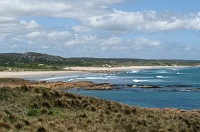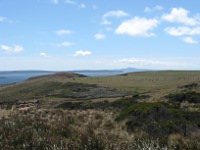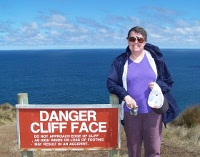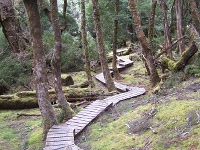Photo albums from this trip are here.
On Tuesday, 16 February, we took an all-day 4WD Tarkine experience tour. The vehicle was an Oka, a 12-passenger vehicle formerly built by a West Australian company. On our way to the west coast, we passed through farming country, including deer farms.
At the coast, we were able to look out to Cape Grim, and take photos. From our viewpoint could see the massive WoolNorth wind farm in the distance, mostly with turbines turning. At Preminghana aboriginal lookout we could see more of the WoolNorth wind farm, although it was still very distant.
Marrawah was the most north westerly real town we would reach. A short distance on we stopped at Green Point beach for morning tea. There was a nice hut with barbecue space, plus toilet facilities. The beach was spacious, and had hardly anyone on it, although there were a dozen or so campervans nearby. We had a morning tea of three Ashgrove Tasmanian cheeses and a dried fruit (apricots, dates) platter, plus tea or coffee.
Nettle Bay, and we are now reaching old Pre Cambrian rocks, not the recent (ten million years) basalt of further east such as The Nut at Stanley. There was far less farmland now we were off the new basalt and on ground that consisted of ancient rocks.
 We drove south along the west coast, until we reached the West Point of Tasmania. We continued through the sand dunes. and crossed the Arthur River. The foreshore along both sides of the river, and for a considerable distance along the coast, was covered with tree trunks. These were trees that had washed down during floods, and been cast up on the shore. Back from the shore are massive Aboriginal midden heaps. In some you can find sharp stone tools, scrapers and the like, for dealing with shells.
We drove south along the west coast, until we reached the West Point of Tasmania. We continued through the sand dunes. and crossed the Arthur River. The foreshore along both sides of the river, and for a considerable distance along the coast, was covered with tree trunks. These were trees that had washed down during floods, and been cast up on the shore. Back from the shore are massive Aboriginal midden heaps. In some you can find sharp stone tools, scrapers and the like, for dealing with shells.
For lunch we had a very nice cold cuts salad, with Atlantic salmon as well as turkey and ham, and Tasmanian Ninth Island wine.
After lunch we returned through the interior of the Tarkine Wilderness. We did part of the South Arthur Forest Drive and Julius River Forest Reserve walk. The Tarkine Wilderness was the last refuge of the extinct marsupial Tasmanian Tiger. The Tarkine will probably be the last refuge of the carnivorous marsupial Tasmanian Devil. The strange Devil Facial Tumor Disease that afflicts them, and which is passed on like an infection during breeding fights, has not yet reached the Tarkine population of Tasmanian Devils. Once it does, the Tasmanian Devil may become extinct.
For dinner Jean enjoyed the linguini pasta with chicken and garlic cream sauce and some more Pinot Noir.
 Our adventure on Wednesday, 17 February, was a one-hour tour of the WoolNorth Wind Farm, followed by a tour of the WoolNorth agricultural station. We had to drive 40 minutes from Smithton to the entrance gate, where we were met by the tour vehicle.
Our adventure on Wednesday, 17 February, was a one-hour tour of the WoolNorth Wind Farm, followed by a tour of the WoolNorth agricultural station. We had to drive 40 minutes from Smithton to the entrance gate, where we were met by the tour vehicle.
The wind farm is owed by Hydro Tasmania, who bought 3000 hectares of land from WoolNorth, and lease agricultural use back to them. Cattle roam unconcerned near the wind turbines. Eagles do less well. Around 10 eagles have died since the farm was built. An observer program, and halting wind turbines when eagles approach, has left the past several years fatality free. It seems eagles do not notice the moving blades. Nor do they notice power lines, which now have anti-eagle fittings to make them more noticeable. With wind turbines needing to be close to the coast, we assume these are white bellied sea eagles, of which Tasmania has fewer than 200 pairs.
We got to drive up close and personal to one of the smaller wind turbines, one of thirty each rated at 1.75MW. These Tasmanian built towers are 60 metres high, and have 66 metre fibreglass blades from Denmark driving the Denmark Vesta generators. They work with wind speeds from 15 KPH to 90 KPH, at which point they need to stop to protect the blades against travelling at more than 33 RPM. They are impressive up close.
As the wind was light, the wind turbines were not making a real lot of noise, although it was noticeable directly under them.
The second stage of the wind farm was going to be identical, however advances in wind turbines produced 3.5 MW turbines, on 80 metre towers, with 90 metre blades. So fewer needed to be built. These are so tall that instead of steps inside for the field staff, they have an elevator device. Alas, these were not part of the visit.
There was a shed nearby with an exhibit about both the wind turbines and the general Cape Grim area. It even included one of the sample bottles used by the Cape Grim air quality monitoring station, the only such station in Australia.
The bus dropped most of the passengers back at the wind farm gate. Only five of us were continuing with the rest of the farm tour.
WoolNorth once had 40,000 sheep, but now the farm is moving to grass fed cattle. They originally had Fresian cattle, but are now changing to Angus. Male calves are not slaughtered as is typical, but kept until they are 18 months old. They are separated into groups of 20 with single strand electric fencing before they get aggressive. Always in the same groups, always with same neighbouring groups. Reduces aggression and pecking order fights. The meat is sold to the US fast food market, as it is too lean for regular eating. The fast food places add the amount of fat they need from other sources.
While driving, we saw flocks of migratory Cape Barren geese on the extensive WoolNorth fields. In 1825, King George IV granted the Van Dieman’s Land Company 350,000 acres of land. The Company, Royal Charter intact, still farms on the 50,000 acres (22,000 hectare) WoolNorth property. This farm occupies the entire north west tip of Tasmania.

 We had great mobile phone reception. Cape Grim Telstra tower was alongside the Cape Grim air quality monitoring station. This air sampling station is situated so air reaching it has travelled up to 20,000 km across empty ocean from South America. It is even lower in the roaring forties trade winds than Africa, some 12,000 km away. The landscape here is old, pre Cambrian, with no recent incursions. As a result, carbon dioxide and other readings from the air station are very reliable, unlike that of stations situated on the top of recently active volcanoes. Although we were able to see the air station at a considerable distance, we could not drive anywhere near it. The exhaust of one vehicle throws off the readings. Indeed, readings are only taken when the wind is from the west (as it mostly is).
We had great mobile phone reception. Cape Grim Telstra tower was alongside the Cape Grim air quality monitoring station. This air sampling station is situated so air reaching it has travelled up to 20,000 km across empty ocean from South America. It is even lower in the roaring forties trade winds than Africa, some 12,000 km away. The landscape here is old, pre Cambrian, with no recent incursions. As a result, carbon dioxide and other readings from the air station are very reliable, unlike that of stations situated on the top of recently active volcanoes. Although we were able to see the air station at a considerable distance, we could not drive anywhere near it. The exhaust of one vehicle throws off the readings. Indeed, readings are only taken when the wind is from the west (as it mostly is).
Morning tea was at the Director’s Lodge, a splendid sprawling, low slung wooden residence overlooking the property. Coming from termite country, we do not often get to appreciate the warmth of wooden interiors.
For dinner Jean had the three rib rack of lamb with broccolini, and a side salad. Eric had the pork bellies on broccolini and rice.
On Thursday, 18 February, we said farewell to the Tall Timbers and set off for Cradle Mountain. The drive from Smithton took us back past Wynyard on the major coast road. The road inland was slower, as it had more turns and more hills. There were some delays because the roads were being repaired.
We stopped after we crossed the Hellyer River for a short circular walk in the Hellyer Gorge State Preserve. The Hellyer eventually joins the Arthur River. There were far too many mosquitoes around the car park area. There was a very easy path, most of it alongside the river. We never did spot any of the reputed giant freshwater crayfish, but they are rare.

 We reached the Cradle Mountain Wilderness Village a little before 1 p.m. and were soon settled in our comfortable and spacious two room cabin (with kitchenette). After unpacking the car, we drove along the narrow, often single lane road past the Visitor’s Centre and Ranger Station and another 7.5 kilometres to Dove Lake. This is a very slow drive due to cut outs designed to slow vehicle traffic and help protect the native animals, which have no road sense. The walk was too long (6 km) and in places too rugged for me, so I dropped Eric off at the Dove Lake car park and returned to the cabin for a nap. I could have gone a few hundred metres to some viewpoints, but was too lazy. Eric managed the full circuit, plus a short side trip to Lake Lilla lookout, in 1 hour 40 minutes.
We reached the Cradle Mountain Wilderness Village a little before 1 p.m. and were soon settled in our comfortable and spacious two room cabin (with kitchenette). After unpacking the car, we drove along the narrow, often single lane road past the Visitor’s Centre and Ranger Station and another 7.5 kilometres to Dove Lake. This is a very slow drive due to cut outs designed to slow vehicle traffic and help protect the native animals, which have no road sense. The walk was too long (6 km) and in places too rugged for me, so I dropped Eric off at the Dove Lake car park and returned to the cabin for a nap. I could have gone a few hundred metres to some viewpoints, but was too lazy. Eric managed the full circuit, plus a short side trip to Lake Lilla lookout, in 1 hour 40 minutes.
This night we ate unexciting food from the shop in the caravan park next door. We had ordered a gourmet breakfast basket for two, which provided two breakfasts and some snacks. The spa bath was most enjoyable, especially for Eric’s tired legs.
On Friday, 19 February, we took the shuttle bus to the ranger station and visitors centre. There are several short walks from nearby. The shortest is to Pencil Pine Falls. This boardwalk is designed so it can be covered in a wheelchair. Again we saw a pademelon (kangaroo variety) along the side of one of the lookouts. The falls were attractive, albeit small.
 Next we went past the Lodge and headed along the slightly longer track to Knyvet Falls. This had more steps in the walk. Jean nearly stepped on a pademelon, which was sitting alongside the narrow boardwalk. The pademelon moved into the nearby brush, and was soon difficult to see. The vegetation gave way to moss covered fallen logs. It was like some medieval fairy story. At one spot the subdued green was brightened by a prominent fist sized orange fungi.
Next we went past the Lodge and headed along the slightly longer track to Knyvet Falls. This had more steps in the walk. Jean nearly stepped on a pademelon, which was sitting alongside the narrow boardwalk. The pademelon moved into the nearby brush, and was soon difficult to see. The vegetation gave way to moss covered fallen logs. It was like some medieval fairy story. At one spot the subdued green was brightened by a prominent fist sized orange fungi.
We eventually reached the Knyvet Falls. We really could only see them side on. Then we had to walk back, diverting along the side path to get a different view of the Pencil Pine Falls.
 Next was the reasonably flat Enchanted Walk, all along a creek that crosses the road near the Lodge. This was an easy walk, with several hides for watching for animals to feed. There seemed a few more people along this walk. By then I was tired of walking, so we went to the Lodge tavern bar for lunch. Jean had the scotch fillet with vegetables, with a pot of James Boag Draught beer, then a Cascade Green (an ecologically sound, carbon neutral light lager; not a colour), not nearly as much to her taste as the Boag. Eric had the Lodge Sandwich, with bacon, turkey, brie, cranberry sauce and salad, which came with a pile of chips. He also had a pint of the James Boag Wizard Smith English ale.
Next was the reasonably flat Enchanted Walk, all along a creek that crosses the road near the Lodge. This was an easy walk, with several hides for watching for animals to feed. There seemed a few more people along this walk. By then I was tired of walking, so we went to the Lodge tavern bar for lunch. Jean had the scotch fillet with vegetables, with a pot of James Boag Draught beer, then a Cascade Green (an ecologically sound, carbon neutral light lager; not a colour), not nearly as much to her taste as the Boag. Eric had the Lodge Sandwich, with bacon, turkey, brie, cranberry sauce and salad, which came with a pile of chips. He also had a pint of the James Boag Wizard Smith English ale.
Page last updated 25 July 2010.
